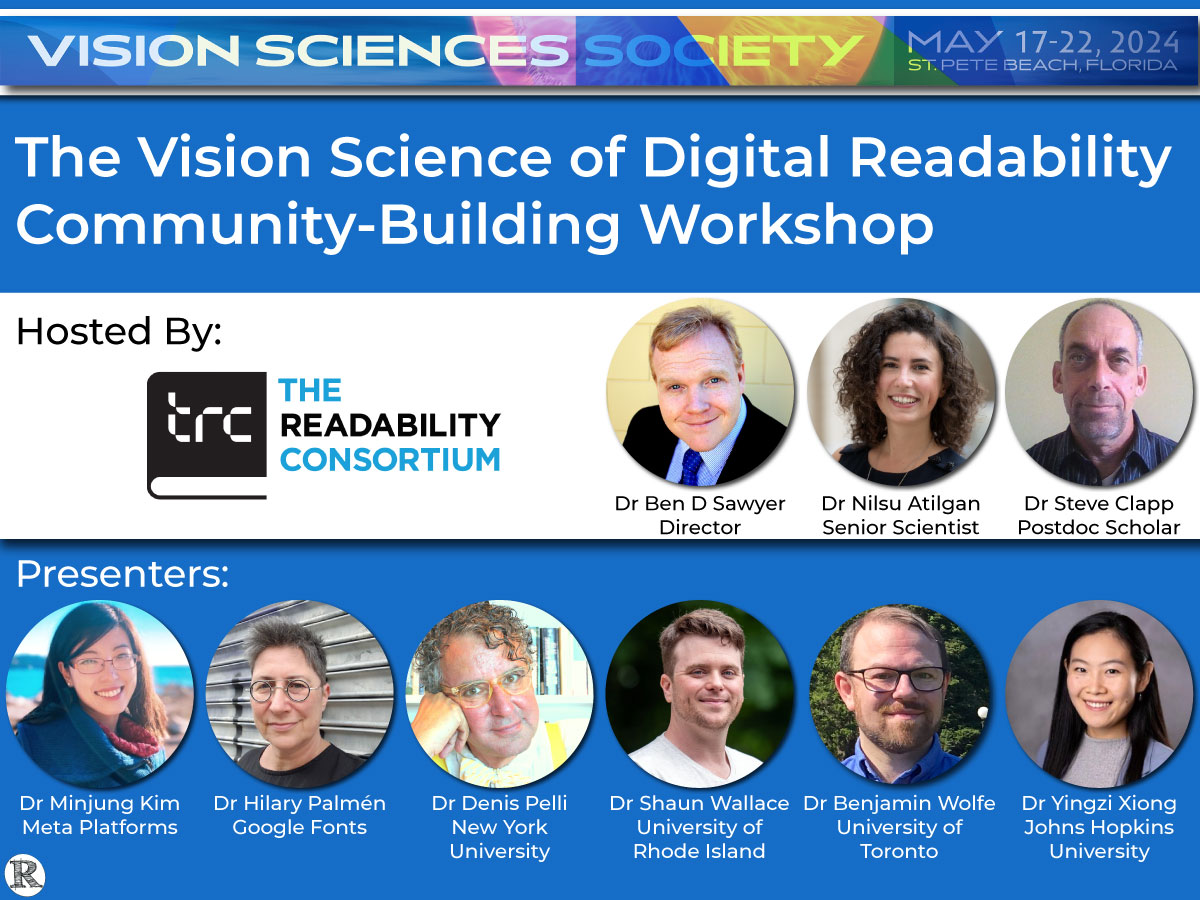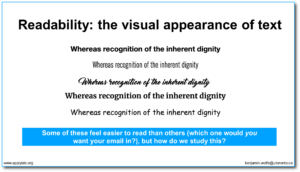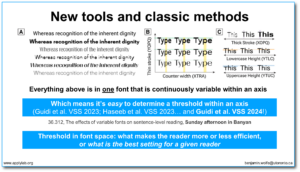Community-Building Workshop Summary
Dr. Nilsu Atilgan
The Readability Consortium
guest author
The Readability Consortium organized a satellite event at the annual meeting of the Vision Science Society (VSS) in St. Pete Beach, Florida, in May. This satellite event served as a community-building workshop at the most prestigious vision science conference, hosting experts from several different fields of vision sciences.
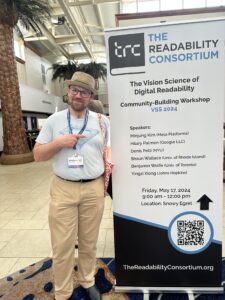
Dr. Benjamin Wolfe, University of Toronto
The workshop started with opening remarks from Dr. Ben D. Sawyer, the director of The Readability Consortium (TRC), and Dr. Nilsu Atilgan, a senior scientist at TRC, both emphasizing the complexity of “reading” as a daily task and the importance of building community around this complicated research area.
As the scientists well stated, reading is a very complex task. A visual object (e.g., the components of a letter) reaches our retina and converts the image of the object to a signal. The signal proceeds to the primary visual cortex (V1) in the brain. Then, it moves along the visual system and higher-level brain areas while completing letter recognition, word recognition, and comprehension.
While executing these steps, one’s visual system must precisely operate peripheral visual perception, attention, and eye movements in a timely manner. Each of these steps is a huge research area. As we all know, reading is much more complex than the few sentences here describing it. What happens if a person has low vision or a learning disability? How do display settings in the digital world affect this process? What if the text is moving? What about mixed reality? How does it work in different scripts and languages?
Of course, an individual researcher or a single research group can’t dive into all of these topics; however, with a community like the one we aim to establish here, everybody can learn more about them, and scientists can incorporate them into the process of thinking about their own research questions. As everybody takes all of these aspects into consideration, the future of reading research can become more inclusive and effective.
In the workshop, reflecting this multidisciplinary nature of reading processes, six speakers from different disciplines gave a talk. The first speaker, Dr. Minjung Kim from Meta Platforms, talked about why we should study reading in the age of extended reality. Next, Dr. Benjamin Wolfe (University of Toronto) and Dr. Shaun Wallace (University of Rhode Island) highlighted how the vision science of readability draws on new digital tools as well as psychophysical techniques and how to study digital text’s physical size on different screens. Following them, Dr. Yingzi Xiong (Johns Hopkins University) turned the conversation to reading with low vision in the digital era. After that, Dr. Hilary Palmén from Google discussed incorporating inclusive characters and script into the research agenda. Lastly, Dr. Denis Pelli (New York University) reviewed the connection between eye comfort, perception of beauty, and visual crowding in reading fonts.
Following each speaker, many questions were raised, leading to a rich discussion of ideas. The conference room was over capacity; many attendees stood the entire time.
After the lively talks, Dr. Steve Clapp, a postdoctoral researcher at TRC, facilitated a brainstorming session with the attendees. The objective was to surface the opportunities and challenges in digital reading research and lay the groundwork for new research collaborations among the attendees and with TRC.
The attendees left inspired and equipped with new insights and connections to advance reading research. The novel workshop was so successful that TRC was invited to host it next year at VSS’s 2025 conference.

![]()
Readability Poster Presentations
Cortical Activations for Symmetry Effect on Visual Word Form Perception in Developmental Dyslexia
Shao-Chin Hung (National Taiwan University, Academia Sinica), Hsiao-Lan Sharon Wang (National Taiwan Normal University), Chien-Chung Chen (National Taiwan University)
Conservation of Cortical Crowding Distance Across Eccentricities in Human V4
Zelin (Linda) Zhao (New York University), Noah C. Benson (University of Washington), Jan W. Kurzawski (New York University), Denis Pelli (New York University), Jonathan Winawer (New York University)
The Effects of Variable Fonts on Sentence-Level Reading
Silvia Guidi, Zainab Haseeb, Anna Kosovicheva, Benjamin Wolfe (University of Toronto Mississauga)
Light or Bold? Navigating Font Weights and Grades for Enhanced Readability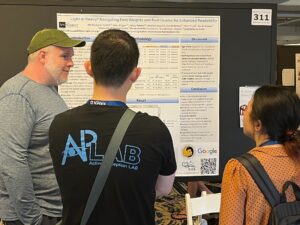
(Md Mamunur Rashid, Nilsu Atilgan, Hilary Palmén, Jonathan Dobres, Sam M Berlow, Mert Küçük, Ben D. Sawyer)
A psychophysical approach for investigating format readability online
(Kurtuluş Mert Küçük, Md Mamunur Rashid, Veronica Penkova, Amy E. Giroux, Nilsu Atılgan, Shaun Wallace, Sam Berlow, Anna Kosovicheva, Stephanie Day, Ben D. Sawyer)
Typeface Matters: Psychophysical Insights into Readability Across Different Reading Tasks
(Nilsu Atilgan, Jonathan Dobres, Md Mamunur Rashid, Sam M Berlow, Ben D. Sawyer)
![]()
Organizers
Dr. Ben D. Sawyer, University of Central Florida
Dr. Nilsu Atilgan, The Readability Consortium
Dr. Steve Clapp, University of Central Florida
Additional Speakers
Dr. Minjung Kim, Meta Reality Labs, USA
Dr. Hilary Palmén, Google LLC, USA
Dr. Denis Pelli, New York University, USA
Dr. Shaun Wallace, University of Rhode Island, USA
Dr. Ben Wolfe, University of Toronto Mississauga, Canada
Dr. Yingzi Xiong, John Hopkins University, USA
![]()
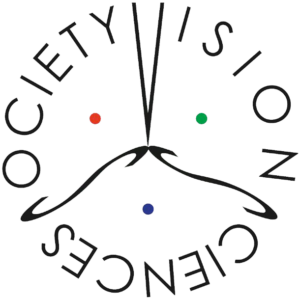 About the Vision Sciences Society: The Vision Sciences Society is a nonprofit membership organization of scientists who are interested in the functional aspects of vision. VSS was founded in 2001 with the main purpose of holding an annual meeting that brings together in one forum scientists from the broad range of disciplines that contribute to vision science, including visual psychophysics, neuroscience, computational vision and cognitive psychology. The scientific content of the meetings reflects the breadth of topics in modern vision science, from visual coding to perception, recognition and the visual control of action, as well as the recent development of new methodologies from cognitive psychology, computer vision and neuroimaging.
About the Vision Sciences Society: The Vision Sciences Society is a nonprofit membership organization of scientists who are interested in the functional aspects of vision. VSS was founded in 2001 with the main purpose of holding an annual meeting that brings together in one forum scientists from the broad range of disciplines that contribute to vision science, including visual psychophysics, neuroscience, computational vision and cognitive psychology. The scientific content of the meetings reflects the breadth of topics in modern vision science, from visual coding to perception, recognition and the visual control of action, as well as the recent development of new methodologies from cognitive psychology, computer vision and neuroimaging.

